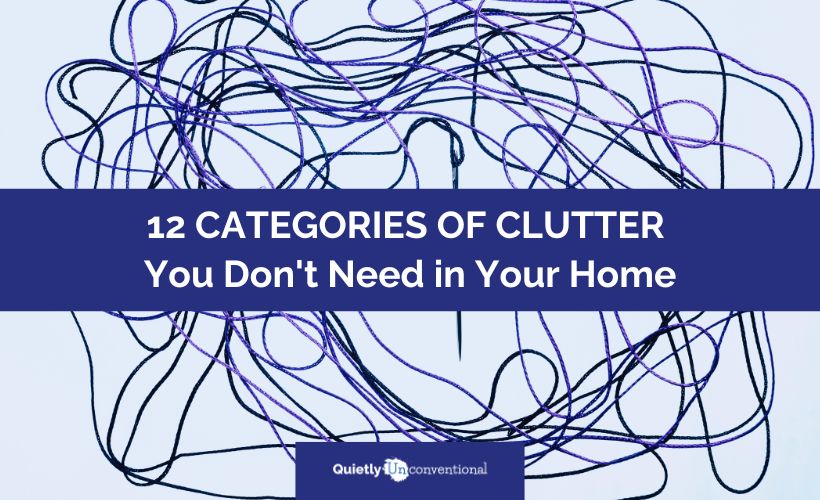Living in the same house for over twenty years inevitably results in excess stuff. In this post, I explain twelve categories of clutter you can do without, so you can more easily identify what to keep and what to toss.
Experts agree that excess stuff (ie clutter) leads to frustration, wasted time and extra stress—which impacts our wallet, our productivity and our happiness.
Who needs that?
So I’ve gone on a de-clutter campaign. As I’ve sorted through junk drawers, closets, and bookshelves, I’ve discovered that when I can identify why an item qualifies as clutter, it’s easier to part with it. Maybe it will help you too.
Twelve categories of clutter you don’t need in your home
- Nostalgic – Stuff you keep for sentimental reasons. Posters from your college dorm room, the program from a Broadway show you saw in 1997, that favorite sweatshirt you should no longer be wearing (especially in public), the wonky basket you made at that retreat… Take a photo for your scrapbook, if you must, then throw it out.
- Outgrown and outdated – Things that don’t fit, are no longer in style or don’t belong in your present phase of life: Like the curtains from the previous incarnation of the living room, music in a genre you no longer enjoy, an entire bin of infant toys, or leftover paper goods from a Toy Story-themed birthday party. You may want to keep a few children’s items for future grandkids, but be reasonable. And give the rest away.
- Waste not – Do you have an excess of useful items, such as twenty take-out containers, eight florist shop vases, four pairs of used sneakers for messy jobs, or duplicate wedding presents? Yes, they are all perfectly good, but you don’t need more than one or two. Give the rest away.
- Bargain – We’ve all acquired stuff because it was too good a deal to pass up. A $3 shirt, that lamp the neighbor was going to throw away, treasures from Aunt Edith’s attic, happy meal junk, free samples from stores or conferences, etc. But a good deal is only a good deal if it’s actually useful. If you’re not using it, don’t keep it.
- Buyer’s remorse Those impulse buys, purchased in a moment weakness. We wish we hadn’t wasted our money on them, but we did, and now we feel guilty if we don’t get our money’s worth. Forget the guilt. Admit your mistakes, and get rid of the junk.
- Pantry Creep. (And the related freezer creep, closet creep, & garage creep) – A condition where you buy more of an item you already have because you forgot you already bought more of it. Often the result of disorganized, overstuffed storage areas. Organize, consolidate, and vow in future not to buy non-perishables that aren’t on the list.
- Good intentions. – All that stuff you aspire to use, but honestly never will: Books you think you ought to read, clever kitchen gadgets that are too hard to clean, craft supplies to make that cool centerpiece you saw on Pinterest, odd ingredients you bought for a recipe from a cooking show you watched six months ago, etc. Give yourself permission to “be you” and get rid of items you only wish you wanted to use.
- Favorites – We each have certain favorite things we want to keep forever, even if we’ll never use them again. In my case, it’s books. For others it may be Christmas decorations, or shoes, or every issue of National Geographic since 1982. Bite the bullet and pare your collection to a reasonable amount of shelf space.
- Informational – Documents, address lists, recipes, book suggestions, research for your work-in-progress, that website you want to remember for next Christmas… Keeping on top of all the information we process is a daunting task, but if it gets out of hand, it can become a nightmare. If you can’t find what you’re looking for, it’s time to attack the piles.
- Fixable – Clothes or other items that could be repaired, if you ever took the time and energy to bother. Be honest; if you really needed it, you would have fixed it by now. Either repair it immediately or throw it out!
- I might need It – We live in a land of abundance. There is no shortage of empty boxes, spare hardware, or whatever else you think you might have a use for some day. Don’t clutter up your house with stuff that belongs in the recycle bin.
- Loose ends – clutter can be mental as well as physical. All those nagging tasks we keep putting off clutter up our brains and feed our stress and guilt levels. We’ll feel better if we can cross some of them off our mental list.
So, which types of clutter do you struggle with and which ones do you have control over? For me, the Good Intention category was the biggest–and most freeing–revelation. Getting rid of items-I-only-wish-I’ll-use not only removed clutter, but also the guilt for not using them. And I can console myself that, because I’ve given them away, someone else can use them.
I’d love to hear your favorite tricks for fighting clutter. Please leave me a comment.
Want to fight clutter but don’t know where to start?
Check out these posts on fighting clutter
7 tips to fight clutter like a pro
How an attitude of generosity helps you declutter
49 things you don’t need and won’t miss
Happy Spring cleaning!


I’m sure I could find things in every category. I like what Fly Lady
(www.flylady.net) would say about clutter: If you don’t love it, don’t
keep it. I went on a big de-cluttering campaign before we moved
13 years ago and need to start all over again. Definitely have creep
and good intentions everywhere in the house!
Clutter creeps up on us in so many subtle ways. That’s why I thought identifying the types was so useful. I am happy to say that (for the moment) I am not suffering from pantry creep, although I was a few months ago.
You forgot – and when you throw it out or give it away hide it from your husband……
That comes in next week’s how-to article. 🙂
Lol. I’m at my dad’s right now. I have taken 2 Suburban loads full of stuff to Goodwill, one trip to the recycle center, and have not made a dent. Will go home and purge some more.
I am dreading the day I must face my parent’s basement, or my in-law’s garage.